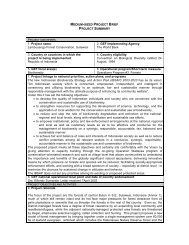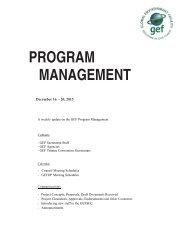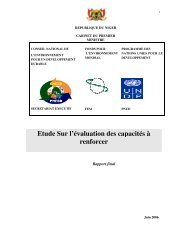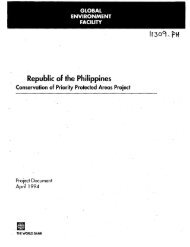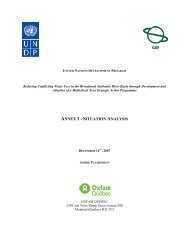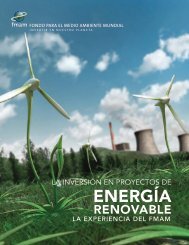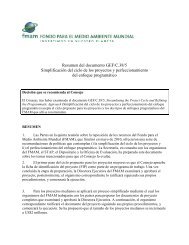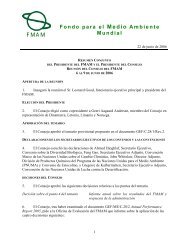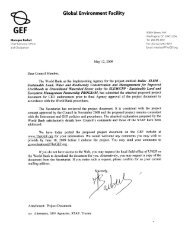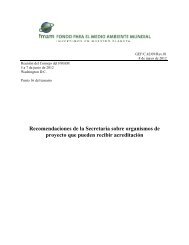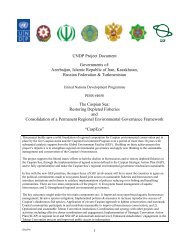English - Global Environment Facility
English - Global Environment Facility
English - Global Environment Facility
Create successful ePaper yourself
Turn your PDF publications into a flip-book with our unique Google optimized e-Paper software.
GEF-4 Tracking Tool for Biodiversity Focal Area Strategic<br />
Objective One:<br />
Catalyzing Sustainability of Protected Area<br />
7. Natural system modifications<br />
Threats from other actions that convert or degrade habitat or change the way the ecosystem functions<br />
High Medium Low N/A<br />
x 7.1 Fire and fire suppression (including arson)<br />
x 7.2 Dams, hydrological modification and water management/use<br />
x 7.3a Increased fragmentation within protected area<br />
x 7.3b Isolation from other natural habitat (e.g. deforestation, dams without<br />
effective aquatic wildlife passages)<br />
x 7.3c Other ‘edge effects’ on park values<br />
x 7.3d Loss of keystone species (e.g. top predators, pollinators etc)<br />
8. Invasive and other problematic species and genes<br />
Threats from terrestrial and aquatic non-native and native plants, animals, pathogens/microbes or<br />
genetic materials that have or are predicted to have harmful effects on biodiversity following<br />
introduction, spread and/or increase<br />
High Medium Low N/A<br />
x 8.1 Invasive non-native/alien plants (weeds)<br />
x 8.1a Invasive non-native/alien animals<br />
x 8.1b Pathogens (non-native or native but creating new/increased<br />
problems)<br />
x 8.2 Introduced genetic material (e.g. genetically modified organisms)<br />
9. Pollution entering or generated within protected area<br />
Threats from introduction of exotic and/or excess materials or energy from point and non-point sources<br />
High Medium Low N/A<br />
x 9.1 Household sewage and urban waste water<br />
x 9.1a Sewage and waste water from protected area facilities (e.g. toilets,<br />
hotels etc)<br />
x 9.2 Industrial, mining and military effluents and discharges (e.g. poor<br />
water quality discharge from dams, e.g. unnatural temperatures, de-<br />
oxygenated, other pollution)<br />
x 9.3 Agricultural and forestry effluents (e.g. excess fertilizers or<br />
pesticides)<br />
x 9.4 Garbage and solid waste<br />
x 9.5 Air-borne pollutants<br />
x 9.6 Excess energy (e.g. heat pollution, lights etc)<br />
10. Geological events<br />
Geological events may be part of natural disturbance regimes in many ecosystems. But they can be a threat if a species or habitat<br />
is damaged and has lost its resilience and is vulnerable to disturbance. Management capacity to respond to some of these changes<br />
may be limited.<br />
High Medium Low N/A<br />
x 10.1 Volcanoes<br />
x 10.2 Earthquakes/Tsunamis<br />
x 10.3 Avalanches/ Landslides<br />
x 10.4 Erosion and siltation/ deposition (e.g. shoreline or riverbed changes)<br />
11. Climate change and severe weather<br />
Threats from long-term climatic changes which may be linked to global warming and other severe climatic/weather events<br />
outside of the natural range of variation<br />
High Medium Low N/A<br />
x 11.1 Habitat shifting and alteration<br />
x 11.2 Droughts<br />
x 11.3 Temperature extremes<br />
x 11.4 Storms and flooding<br />
12. Specific cultural and social threats<br />
High Medium Low N/A<br />
x 12.1 Loss of cultural links, traditional knowledge and/or management<br />
practices<br />
x 12.2 Natural deterioration of important cultural site values<br />
x 12.3 Destruction of cultural heritage buildings, gardens, sites etc<br />
14



